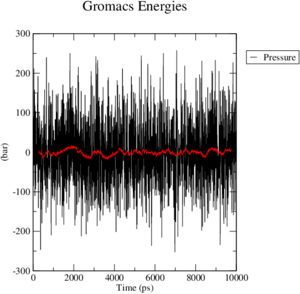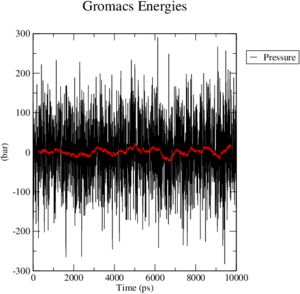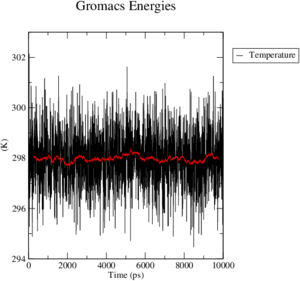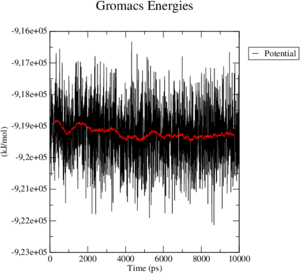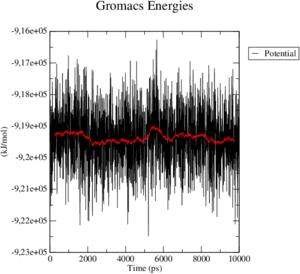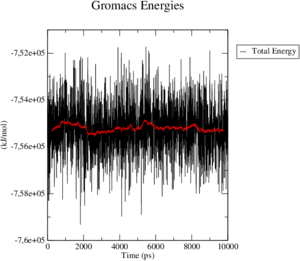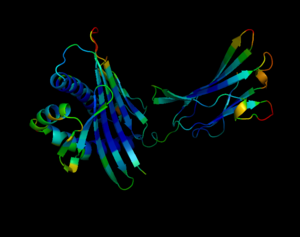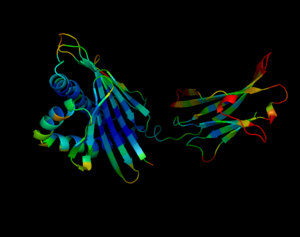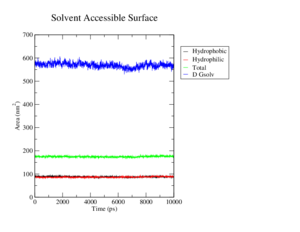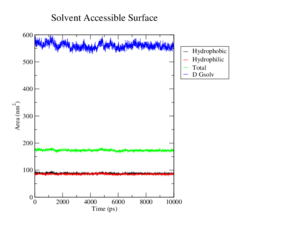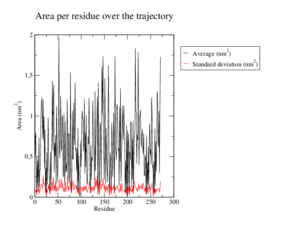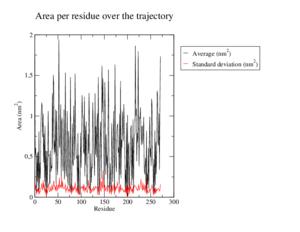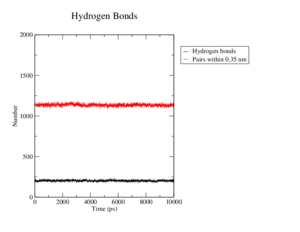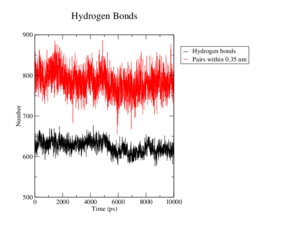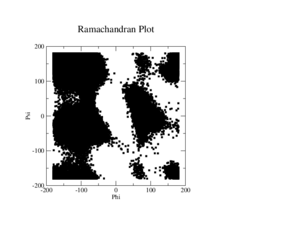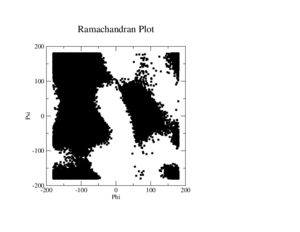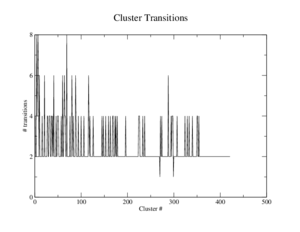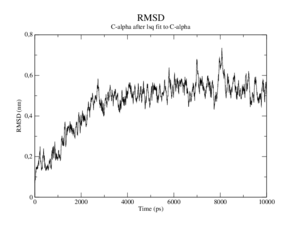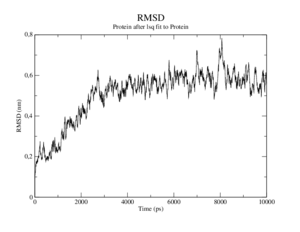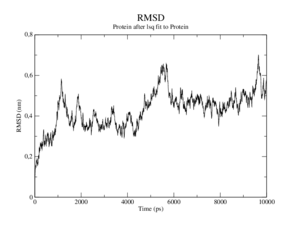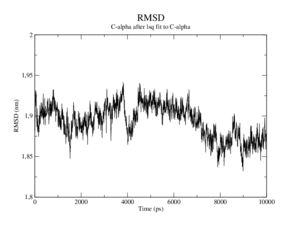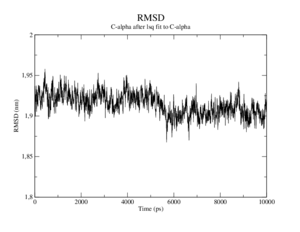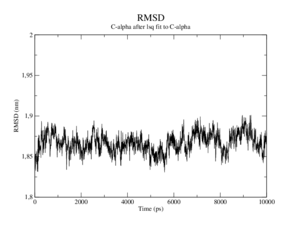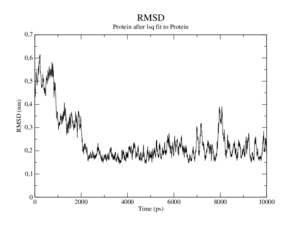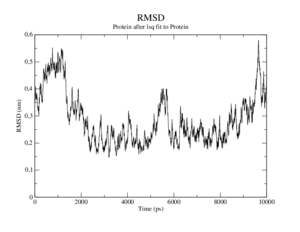Hemochromatosis>>Task 10: Molecular dynamics simulations analysis
Short task description
Detailed description: Molecular dynamics simulations analysis
Protocol
A protocol with a description of the data acquisition and other scripts used for this task is available here.
Dummy
Calculation statistics
<figtable id="tab:simulation_stats">
Statistics of the MD simulations
| Input
|
Calc. time
|
Calc. speed
|
time to reach 1 s
|
| Wildtype
|
13h31:15
|
17.750 ns/day
|
154350,8 years
|
| C282S
|
13h35:05
|
17.667 ns/day
|
155075,9 years
|
| R224W
|
13h35:02
|
17.668 ns/day
|
155067,1 years
|
</figtable>
GMXcheck revealed for all calculations that all 2001 frames were calculated, resulting in a 10ns model.
Energies
Pressure
<figtable id="comparison">
|
|
|
|
|
Table 1: different pressures of the three calculated models over time. From left to right: 1a6zC (wildtype), mutation at position 224 (R224W) and mutatuin at position 282 (C282S)
</figtable>
Temperature
<figtable id="comparison">
|
|
|
|
|
Table 2: different temperature energies of the three calculated models over time. From left to right: 1a6zC (wildtype), mutation at position 224 (R224W) and mutation at position 282 (C282S)
</figtable>
Potential
<figtable id="comparison">
|
|
|
|
|
Table 3: different potential energies of the three calculated models over time. From left to right: 1a6zC (wildtype), mutation at position 224 (R224W) and mutation at position 282 (C282S)
</figtable>
Total energy
<figtable id="comparison">
|
|
|
|
|
Table 1: different total energies of the three calculated models over time. From left to right: 1a6zC (wildtype), mutation at position 224 (R224W) and mutation at position 282 (C282S)
</figtable>
Minimum distance between periodic boundary cells
<figtable id="comparison">
|
|
|
|
|
Table 1: different total energies of the three calculated models over time. From left to right: 1a6zC (wildtype), mutation at position 224 (R224W) and mutation at position 282 (C282S)
</figtable>
RMSF for protein and C-alpha
Protein based
<figtable id="comparison">
|
|
|
|
|
Table 1: different RMS fluctuations (based on the whole protein) of the three calculated models over time. From left to right: 1a6zC (wildtype), mutation at position 224 (R224W) and mutation at position 282 (C282S)
</figtable>
C-Alpha based
<figtable id="comparison">
|
|
|
|
|
Table 1: different tRMS fluctuations (based on the the C-alpha of the backbone of the protein) of the three calculated models over time. From left to right: 1a6zC (wildtype), mutation at position 224 (R224W) and mutation at position 282 (C282S)
</figtable>
Statistical values
|
|
Average
|
StdDeviation
|
Ratio
|
significance
|
| Wildtype
|
0.183621323529412
|
0.0605331780782099
|
50.0281092824371
|
|
| R224W
|
0.232876838235294
|
0.0895836329605749
|
42.87282263833
|
|
| C282S
|
0.268558823529412
|
0.0982244780281883
|
45.0924827835932
|
|
Table 1:
Pymol analysis of average and bfactor
<figtable id="comparison">
|
|
|
|
|
Table 1: different t gyrations (based on the the C-alphas of the backbone of the protein) of the three calculated models over time. From left to right: 1a6zC (wildtype), mutation at position 224 (R224W) and mutation at position 282 (C282S)
</figtable>
Radius of gyration
<figtable id="comparison">
|
|
|
|
|
Table 1: different t gyrations (based on the the C-alphas of the backbone of the protein) of the three calculated models over time. From left to right: 1a6zC (wildtype), mutation at position 224 (R224W) and mutation at position 282 (C282S)
</figtable>
<figtable id="comparison">
|
|
|
|
|
Table 1: different t gyrations (based on the the whole protein) of the three calculated models over time. From left to right: 1a6zC (wildtype), mutation at position 224 (R224W) and mutation at position 282 (C282S)
</figtable>
solvent accessible surface area
<figtable id="comparison">
|
|
|
|
|
Table 1: display of the different solvent accessible surface values of the three calculated models over time. From left to right: 1a6zC (wildtype), mutation at position 224 (R224W) and mutation at position 282 (C282S)
</figtable>
<figtable id="comparison">
|
|
|
|
|
Table 1: display of the different solvent accessible surface values (normalized to per residue values) of the three calculated models over time. From left to right: 1a6zC (wildtype), mutation at position 224 (R224W) and mutation at position 282 (C282S)
</figtable>
hydrogen-bonds between protein and protein / protein and water
Protein-Protein
<figtable id="comparison">
|
|
|
|
|
Table 1: the number of hydrogen bonds inside the protein of the three calculated models over time. From left to right: 1a6zC (wildtype), mutation at position 224 (R224W) and mutation at position 282 (C282S)
</figtable>
Protein-Water
<figtable id="comparison">
|
|
|
|
|
Table 1: the number of hydrogen bonds of the protein with water of the three calculated models over time. From left to right: 1a6zC (wildtype), mutation at position 224 (R224W) and mutation at position 282 (C282S)
</figtable>
Ramachandran plots
<figtable id="comparison">
|
|
|
|
|
Table 1: tramachandran Plots of the three calculated models over time. From left to right: 1a6zC (wildtype), mutation at position 224 (R224W) and mutation at position 282 (C282S)
</figtable>
RMSD matrix
<figtable id="comparison">
|
|
|
|
|
Table 1: rmsd matrices of the three calculated models over time (based on the whole protein). From left to right: 1a6zC (wildtype), mutation at position 224 (R224W) and mutation at position 282 (C282S)
</figtable>
<figtable id="comparison">
|
|
|
|
|
Table 1: rmsd matrices of the three calculated models over time (based on the mainchain and C-betas). From left to right: 1a6zC (wildtype), mutation at position 224 (R224W) and mutation at position 282 (C282S)
</figtable>
cluster analysis
whole protein based
<figtable id="comparison">
|
|
|
|
|
|
|
|
|
|
|
|
Table 1: rmsd matrices of the three calculated models over time (based on the whole protein). From left to right: 1a6zC (wildtype), mutation at position 224 (R224W) and mutation at position 282 (C282S)
</figtable>
C-alpha based
<figtable id="comparison">
|
|
|
|
|
|
|
|
|
|
|
|
Table 1: rmsd matrices of the three calculated models over time (based on the whole protein). From left to right: 1a6zC (wildtype), mutation at position 224 (R224W) and mutation at position 282 (C282S)
</figtable>
internal RMSD
against starting structure
<figtable id="comparison">
|
|
|
|
|
|
|
|
|
|
Table 1: tramachandran Plots of the three calculated models over time. From left to right: 1a6zC (wildtype), mutation at position 224 (R224W) and mutation at position 282 (C282S)
</figtable>
against average structure
<figtable id="comparison">
|
|
|
|
|
|
|
|
|
|
Table 1: tramachandran Plots of the three calculated models over time. From left to right: 1a6zC (wildtype), mutation at position 224 (R224W) and mutation at position 282 (C282S)
</figtable>
References
<references/>

